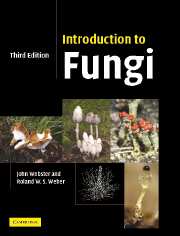Book contents
- Frontmatter
- Contents
- Preface to the first edition
- Preface to the second edition
- Preface to the third edition
- Acknowledgements
- 1 Introduction
- 2 Protozoa: Myxomycota (slime moulds)
- 3 Protozoa: Plasmodiophoromycota
- 4 Straminipila: minor fungal phyla
- 5 Straminipila: Oomycota
- 6 Chytridiomycota
- 7 Zygomycota
- 8 Ascomycota (ascomycetes)
- 9 Archiascomycetes
- 10 Hemiascomycetes
- 11 Plectomycetes
- 12 Hymenoascomycetes: Pyrenomycetes
- 13 Hymenoascomycetes: Erysiphales
- 14 Hymenoascomycetes: Pezizales (operculate discomycetes)
- 15 Hymenoascomycetes: Helotiales (inoperculate discomycetes)
- 16 Lichenized fungi (chiefly Hymenoascomycetes: Lecanorales)
- 17 Loculoascomycetes
- 18 Basidiomycota
- 19 Homobasidiomycetes
- 20 Homobasidiomycetes: gasteromycetes
- 21 Heterobasidiomycetes
- 22 Urediniomycetes: Uredinales (rust fungi)
- 23 Ustilaginomycetes: smut fungi and their allies
- 24 Basidiomycete yeasts
- 25 Anamorphic fungi (nematophagous and aquatic forms)
- References
- Index
- Plate section
3 - Protozoa: Plasmodiophoromycota
- Frontmatter
- Contents
- Preface to the first edition
- Preface to the second edition
- Preface to the third edition
- Acknowledgements
- 1 Introduction
- 2 Protozoa: Myxomycota (slime moulds)
- 3 Protozoa: Plasmodiophoromycota
- 4 Straminipila: minor fungal phyla
- 5 Straminipila: Oomycota
- 6 Chytridiomycota
- 7 Zygomycota
- 8 Ascomycota (ascomycetes)
- 9 Archiascomycetes
- 10 Hemiascomycetes
- 11 Plectomycetes
- 12 Hymenoascomycetes: Pyrenomycetes
- 13 Hymenoascomycetes: Erysiphales
- 14 Hymenoascomycetes: Pezizales (operculate discomycetes)
- 15 Hymenoascomycetes: Helotiales (inoperculate discomycetes)
- 16 Lichenized fungi (chiefly Hymenoascomycetes: Lecanorales)
- 17 Loculoascomycetes
- 18 Basidiomycota
- 19 Homobasidiomycetes
- 20 Homobasidiomycetes: gasteromycetes
- 21 Heterobasidiomycetes
- 22 Urediniomycetes: Uredinales (rust fungi)
- 23 Ustilaginomycetes: smut fungi and their allies
- 24 Basidiomycete yeasts
- 25 Anamorphic fungi (nematophagous and aquatic forms)
- References
- Index
- Plate section
Summary
Introduction
The Plasmodiophoromycota are a group of obligate (i.e. biotrophic) parasites. The best-known examples attack higher plants, causing economically significant diseases such as club-root of brassicas (Plasmodiophora brassicae), powdery scab of potato (Spongospora subterranea; formerly S. subterranea f. sp. subterranea) and crook-root disease of watercress (S. nasturtii; formerly S. subterranea f. sp. nasturtii). In addition to damaging crops directly, some species (S. subterranea, Polymyxa betae, P. graminis) also act as vectors for important plant viruses (Adams, 1991; Campbell, 1996). Other species infect roots and shoots of non-cultivated plants, especially aquatic plants. Algae, diatoms and Oomycota are also attacked. If the nine species of Haptoglossa, which parasitize nematodes and rotifers, are included in the Plasmodiophoromycota, the phylum currently comprises 12 genera and 51 species (Dick, 2001a). Genera are separated from each other largely by the arrangement of resting spores in the host cell (Waterhouse, 1973). This feature has also been used for naming most genera; for instance, in Polymyxa, numerous resting spores are contained within each sorus, whereas in Spongospora the resting spores are grouped loosely in a sponge-like sorus (Fig. 3.6). Accounts of the Plasmodiophoromycota have been given by Sparrow (1960), Karling (1968), Dylewski (1990) and Braselton (1995, 2001).
Taxonomic considerations
Plasmodiophoromycota have traditionally been studied by mycologists and plant pathologists. Many general features of their biology and epidemiology are similar to those of certain members of the Chytridiomycota such as Olpidium (see p. 145).
- Type
- Chapter
- Information
- Introduction to Fungi , pp. 54 - 66Publisher: Cambridge University PressPrint publication year: 2007

